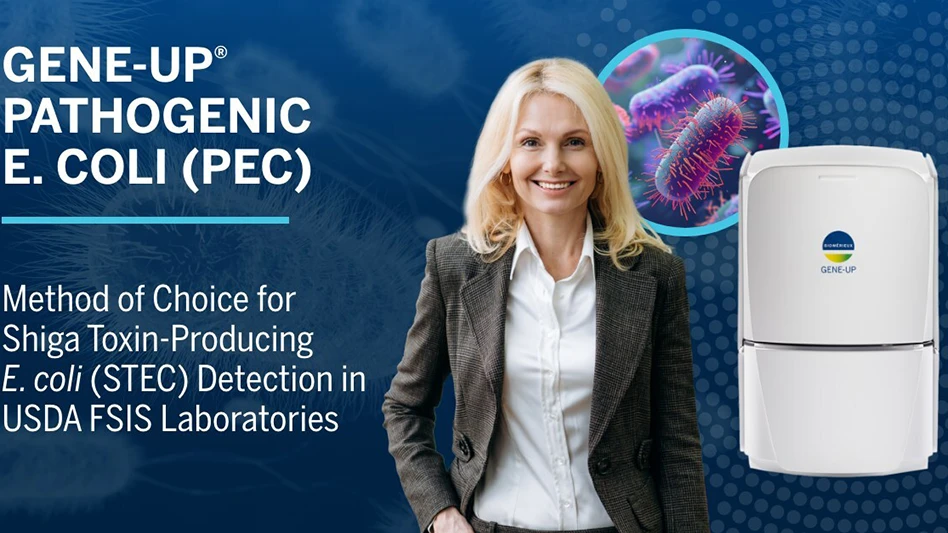
Photo courtesy bioMérieux
CHICAGO — bioMérieux announced that the company's GENE-UP Pathogenic E. coli (PEC) assay has been selected by the USDA-FSIS Field Service Laboratories as the primary method for Shiga toxin-producing E. coli detection.
According to the June 28 USDA Constituent Update, FSIS evaluated commercially available pathogen screening technologies and will adopt a new rapid screening test for adulterant Shiga toxin-producing E. coli (STEC). Specifically, FSIS will use the bioMérieux GENE-UP Pathogenic E. coli (PEC) platform to screen enriched samples received on or after Sept. 16 for adulterant STEC. This screening method employs a novel molecular diagnostic target to rapidly identify samples containing STEC.
FSIS said it expects that adoption of this new screening method will reduce the number of potential and presumptive positive STEC results that do not confirm positive with its current method. The agency said it expects that industry will see reduced product holding times while waiting for laboratory results.
"We are delighted to receive this award from the USDA-FSIS," said Miguel Villa, senior vice president, Americas, industrial applications at bioMérieux. "With the addition of the GENE-UP PEC assay to the FSIS-methods of choice, bioMérieux continues to bring innovation to the market to ensure public health and food safety, playing our part to support food security and sustainability around the world."
GENE-UP PEC is the latest of bioMérieux's molecular diagnostic solutions to be recognized by food safety regulatory bodies in the United States, and pairs with a suite of diagnostic solutions that detect pathogenic E. coli via eae / stx genes, O serogroups and novel co-location of virulence genes allowing for improved presumptive and confirmation analysis of potential positive samples.
Recently, the USDA also awarded bioMérieux the contractfor GENE-UP CAMPYLOBACTER as the FSIS method of choice. Earlier this year, bioMérieux announced a research collaboration to improve microbial detection of foodborne pathogens with the Food and Drug Administration, and in 2022, the USDA named bioMérieux's GENE-UP QUANT Salmonella quantification method of choice in all FSIS laboratories. Now, with GENE-UP, TEMPO, and VITEK solutions currently included in the USDA Microbiology Laboratory Guidebook (MLG), bioMérieux said it holds the most USDA-FSIS methods of choice for microbiology.
"Our Augmented Diagnostics approach was certainly leveraged for this exciting suite of innovations," said John Shultz, senior director, sales and marketing, industrial applications, at bioMérieux. "Harnessing our data and genomics expertise, we bring a unique offering to industries historically challenged with complex and oftentimes convoluted testing process for STECs. We are particularly excited about the inclusion of the GENE-UP PEC assay, which utilizes novel co-location of virulence genes to accurately detect pathogenic E. coli strains, dramatically reducing product hold times and unnecessary food waste."
For more information on GENE-UP, visit https://www.biomerieux.com/us/en/our-offer/industry-products/gene-up-pathogenic-e-coli-pathogen-detection.html.
Latest from Quality Assurance & Food Safety
- IDFA Presents Leadership Award to Six Federal Officials at Annual Celebration of Dairy Reception
- Seeding The Future Global Food System Challenge is Changing Lives: Winners Reflections
- Raw Farm Products Recalled Following Bird Flu Virus Detections
- FDA Issues 2024 Voluntary National Retail Food Regulatory Program Standards
- GSA Launches Assurances Platform, Prism and Webinar Series in Partnership with Wholechain
- Multistate E. coli Outbreak Linked to Iceberg and Romaine Lettuce Blend
- FDA, USDA Seek Information About Food Date Labeling
- William Marler, Food Safety Advocate and Lawyer, Condemns Lack of Safety of U.S. Food Supply





